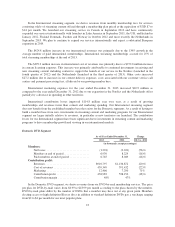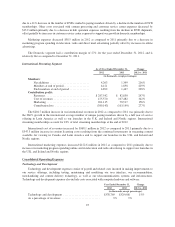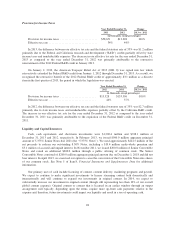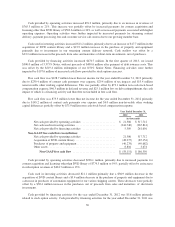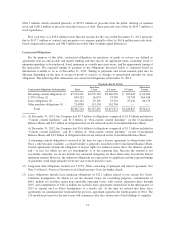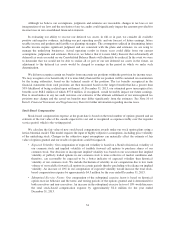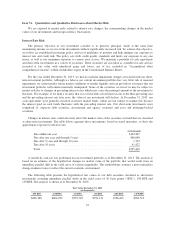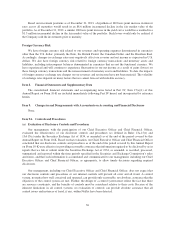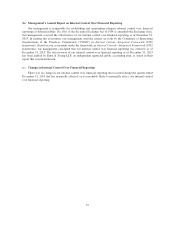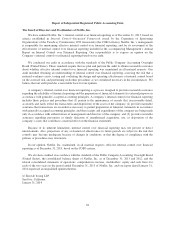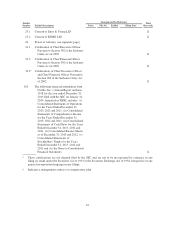NetFlix 2013 Annual Report Download - page 35
Download and view the complete annual report
Please find page 35 of the 2013 NetFlix annual report below. You can navigate through the pages in the report by either clicking on the pages listed below, or by using the keyword search tool below to find specific information within the annual report.We amortize the content library in “Cost of revenues” on a straight line or on an accelerated basis, as
appropriate:
• For content that does not premiere on the Netflix service (representing the vast majority of content), we
amortize on a straight-line basis over the shorter of each title’s contractual window of availability or
estimated period of use, beginning with the month of first availability. The amortization period typically
ranges from six months to five years.
• For content that premieres on the Netflix service, we expect more upfront viewing due to the additional
merchandising and marketing efforts for this original content available only on Netflix. Hence, we
amortize on an accelerated basis over the amortization period, which is the shorter of four years or the
license period, beginning with the month of first availability. If a subsequent season is added, the
amortization period is extended by a year.
• If the cost per title cannot be reasonably estimated, the license fee is not capitalized and costs are expensed
on a straight line basis over the license period. This typically occurs when the license agreement does not
specify the number of titles, the license fee per title or the windows of availability per title.
Amortization of the content library is determined based on our historical and estimated viewing patterns and
requires considerable management judgment. When we started with original content, we did not have specific
data about viewing patterns over time for content that premieres on Netflix. Based on our experience with other
similar television series and our initial estimates of viewing patterns, we amortized content that exclusively
premiered on our service on a straight-line basis over the shorter of four years or the license period. If a
subsequent season is added, we extend the remaining amortization period by a year. Current estimates of viewing
patterns indicate that viewing in the first few months is significantly higher, relative to the rest of the
amortization period, than previously estimated. As a result, in the third quarter of 2013, we began amortizing this
type of content on an accelerated basis over the amortization period. The effect of this change in estimate was a
decrease in operating income and net income of $25.0 million and $15.4 million, respectively for the year ended
December 31, 2013. Any other changes in management’s estimates could have a significant impact on our future
results of operations.
The content library is stated at the lower of unamortized cost or net realizable value. Streaming content
licenses (whether capitalized or not) are reviewed in aggregate at the geographic region level for impairment
when an event or change in circumstances indicates a change in the expected usefulness of the content. The level
of geographic aggregation is determined based on the streaming content rights which are generally specific to a
geographic region inclusive of several countries (such as Latin America). No material write down from
unamortized cost to a lower net realizable value was recorded in any of the periods presented.
We have entered into certain licenses with performing rights organizations (“PROs”), and are currently
involved in negotiations with other PROs, that hold certain rights to music and other entertainment works
“publicly performed” in connection with streaming content into various territories. Accruals for estimated
royalties are recorded and then adjusted based on any changes in estimates. These amounts are included in the
streaming content obligations. The results of these negotiations are uncertain and may be materially different
from management’s estimates.
Income Taxes
We record a provision for income taxes for the anticipated tax consequences of our reported results of
operations using the asset and liability method. Deferred income taxes are recognized by applying enacted
statutory tax rates applicable to future years to differences between the financial statement carrying amounts of
existing assets and liabilities and their respective tax bases as well as net operating loss and tax credit
carryforwards. The effect on deferred tax assets and liabilities of a change in tax rates is recognized in income in
the period that includes the enactment date. The measurement of deferred tax assets is reduced, if necessary, by a
valuation allowance for any tax benefits for which future realization is uncertain.
33


